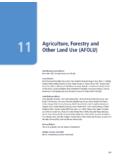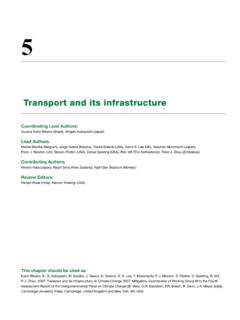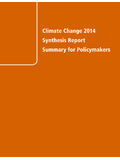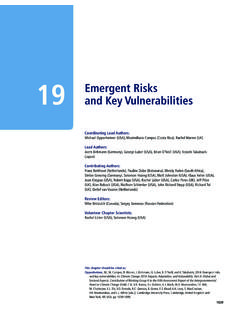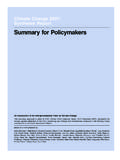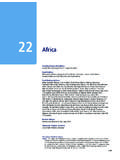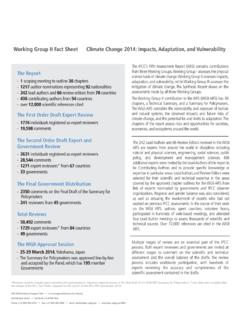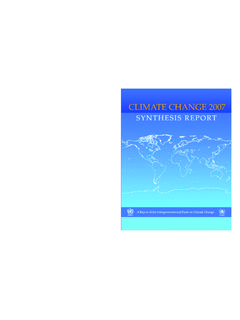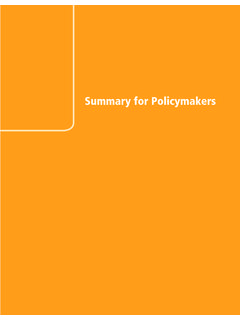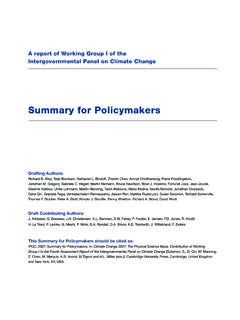Transcription of 5 WASTE - IPCC
1 chapter 5 WasteIPCC Good Practice Guidance and Uncertainty Management in National Greenhouse Gas Good Practice Guidance and Uncertainty Management in National Greenhouse Gas InventoriesCO-CHAIRS, EDITORS AND EXPERTSCo-chairs of the Expert Meeting on Emissions from WasteTaka Hiraishi (Japan) and Buruhani Nyenzi (Tanzania)REVIEW EDITORJos Domingos Miguez (Brazil)Expert Group: CH4 Emissions from Solid WASTE Bhide (India) and Riitta Pipatti (Finland)AUTHORS OF BACKGROUND PAPERJens E. Fr iland Jensen (Norway) and Riitta Pipatti (Finland)CONTRIBUTORSJoao W. de Silva Alves (Brazil), Pascal Boeckx (Belgium), Keith Brown (UK), Robert Hoppaus (IPCC/OECD),Charles Jubb (Australia), Thomas Kerr (USA), Tore Kleffelgaard (Norway), Oswaldo Lucon (Brazil), GerdMauschitz (Austria), Carmen Midaglia (Brazil), Martin Milton (UK), Michael Mondshine (USA), Hans Oonk(Netherlands), Bostjan Paradiz (Slovenia), Katarzyna Steczko (Poland), Egle Novaes Teixeira (Brazil),Sirintornthep Towprayoon (Thailand), and Irina Yesserkepova (Kazakhstan)Expert Group.
2 CH4 and N2O Emissions from Wastewater HandlingCO-CHAIRSM ichiel Doorn (Netherlands) and Faouzi Senhaji (Morocco)AUTHOR OF BACKGROUND PAPERJohn Hobson (UK)CONTRIBUTORSJ uliana Adamkova (Slovak Republic), William Irving (USA), Scarlette Lara (Chile), Kenneth Olsen (Canada),Karin Reuck (Chile), Ingvar Svensson (Sweden), and Sonia Manso Viera (Brazil)Expert Group: Emissions from WASTE IncinerationCO-CHAIRSM artin Bigg (UK) and Newton Paciornik (Brazil)AUTHOR OF BACKGROUND PAPERB ernt Johnke (Germany)CONTRIBUTORSJose Baldasano (Spain), Anke Herold (Germany), Andrej Kranjc (Slovenia), Jozef Kutas (Hungary) , KatarinaMareckova (IPCC/OECD), and Kiyoto Tanabe (Japan) chapter 5 WasteIPCC Good Practice Guidance and Uncertainty Management in National Greenhouse Gas CH4 EMISSIONS FROM SOLID WASTE DISPOSAL SITES.
3 Issues .. and quality assurance/quality control (QA/QC).. EMISSIONS FROM WASTEWATER HANDLING .. issues .. and quality assurance/quality control (QA/QC).. EMISSIONS FROM WASTE issues .. and quality assurance/quality control (QA/QC).. Good Practice Guidance and Uncertainty Management in National Greenhouse Gas InventoriesFiguresFigure Decision Tree for CH4 Emissions from Solid WASTE Disposal Sites .. Decision Tree for CH4 Emissions from Domestic Wastewater Wastewater Flows, Treatment Systems, and Potential CH4 Emissions .. Decision Tree for CH4 Emissions from Industrial Wastewater Decision Tree for CO2 Emissions from WASTE Incineration.
4 Decision Tree for N2O Emissions from WASTE Incineration .. Classification and Methane Correction Factors .. of Uncertainties Associated with the Default Parametersin the IPCC Default and FOD Methods for CH4 Emissions from SWDS .. Uncertainty Ranges for Domestic Wastewater .. Wastewater Uncertainty Ranges for Industrial Wastewater .. Data for Estimation of CO2 Emissions from WASTE Factors for N2O from WASTE Incineration .. 5 WasteIPCC Good Practice Guidance and Uncertainty Management in National Greenhouse Gas CH4 EMISSIONS FROM SOLID WASTEDISPOSAL Methodological issuesMethane (CH4) is emitted during the anaerobic decomposition of organic WASTE disposed of in solid wastedisposal sites (SWDS).
5 Organic WASTE decomposes at a diminishing rate and takes many years to CHOICE OF METHODThe Revised 1996 IPCC Guidelines for National Greenhouse Gas Inventories (IPCC Guidelines) outline twomethods to estimate CH4 emissions from solid WASTE disposal sites, the default method (Tier 1) and the FirstOrder Decay (FOD) method (Tier 2). The main difference between the two methods is that the FOD methodproduces a time-dependent emission profile that better reflects the true pattern of the degradation process overtime, whereas the default method is based on the assumption that all potential CH4 is released in the year thewaste is disposed of.
6 The default method will give a reasonable annual estimate of actual emissions if the amountand composition of deposited WASTE have been constant or slowly varying over a period of several decades. If theamount or composition of WASTE disposed of at SWDS is changing more rapidly over time, however, the IPCC default method will not provide an accurate trend. For example, if there is a reduction in the amount of carbondeposited at SWDS, the default method will underestimate emissions and overestimate choice of a good practice method will depend on national circumstances. The decision tree in Figure ,Decision Tree for CH4 Emissions from Solid WASTE Disposal Sites, illustrates the process of choosing amongmethods.
7 It is good practice to use the FOD method, if possible, because it more accurately reflects theemissions trend. The use of the FOD method requires data on current, as well as historic WASTE quantities,composition and disposal practices for several decades. It is good practice to estimate this historical data, if suchdata are unavailable, when this is a key source category (see chapter 7, Methodological Choice andRecalculation) or if there have been significant changes in WASTE management IPCC Guidelines do not provide default values or methods for the estimation of some key parametersneeded to use the FOD method. These data are very dependent on country-specific conditions, and currentlythere are not enough data available to give reliable default values or methods for them.
8 Inventory agencies areencouraged to obtain data from country-specific or regional research, because the inability of inventory agenciesto use the FOD method where otherwise indicated by good practice would reduce comparability betweennational inventories. Inventory agencies selecting a method other than those described in the IPCC Guidelinesshould justify their selection based on comparable or increased accuracy and completeness of the CHOICE OF EMISSION FACTORS AND ACTIVITY DATAThe discussion of good practice in the choice of activity data and emission factors is combined in this section,due to the unique character of the emission estimation Order Decay (FOD) method Tier 2 The IPCC Guidelines (pp , Reference Manual) present the FOD method in three equations.
9 The firstequation is to be used for an individual landfill, or possibly a group of specific landfills. A second equation,suitable for national and regional estimates, calculates emissions from all solid WASTE deposited in SWDS in oneyear. The purpose of the third equation is to estimate current annual emissions from WASTE disposal in current andprevious Good Practice Guidance and Uncertainty Management in National Greenhouse Gas InventoriesFigure Decision Tree for CH4 Emissions from Solid WasteDisposal SitesThe FOD method can be expressed equivalently by Equation and Equation below. Equation is basedon the derivative of the general FOD equation (see p , Reference Manual, IPCC Guidelines) with t replacedby t x, representing a normalisation factor that corrects for the fact that the evaluation for a single year is adiscrete time estimate rather than a continuous time generated in year t (Gg/yr) = x [(A k MSWT (x) MSWF (x) L0(x)) e k(t x)]for x = initial year to tWhere:t = year of inventoryx = years for which input data should be addedA = (1 e k) / k.
10 Normalisation factor which corrects the summationk = Methane generation rate constant (1/yr)MSWT (x) = Total municipal solid WASTE (MSW) generated in year x (Gg/yr)MSWF (x) = Fraction of MSW disposed at SWDS in year xL0 (x) = Methane generation potential [MCF (x) DOC (x) DOCF F 16 / 12 (Gg CH4/Gg WASTE )]Box 1 NoBox 2 NoYesAre wastedisposal activitydata obtainable for thecurrent inventoryyear?Use IPCC defaultvalues, per capita orother methods toestimate activity dataEstimate CH4emissions using theIPCC defaultmethodAre wastedisposal activity dataavailable for previousyears?Is this akey source category?(Note 1)Estimate CH4emissions using theFirst Order Decay(FOD) methodObtain orestimate data onhistorical changes insolid WASTE disposalYesNoYesNote 1:A key source category is one that is prioritised within the national inventory system because its estimate has a significantinfluence on a country s total inventory of direct greenhouse gases in terms of the absolute level of emissions, the trend in emissions, orboth.
